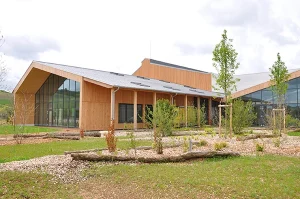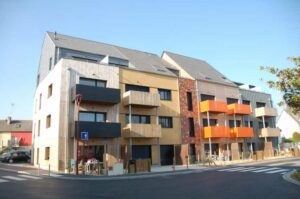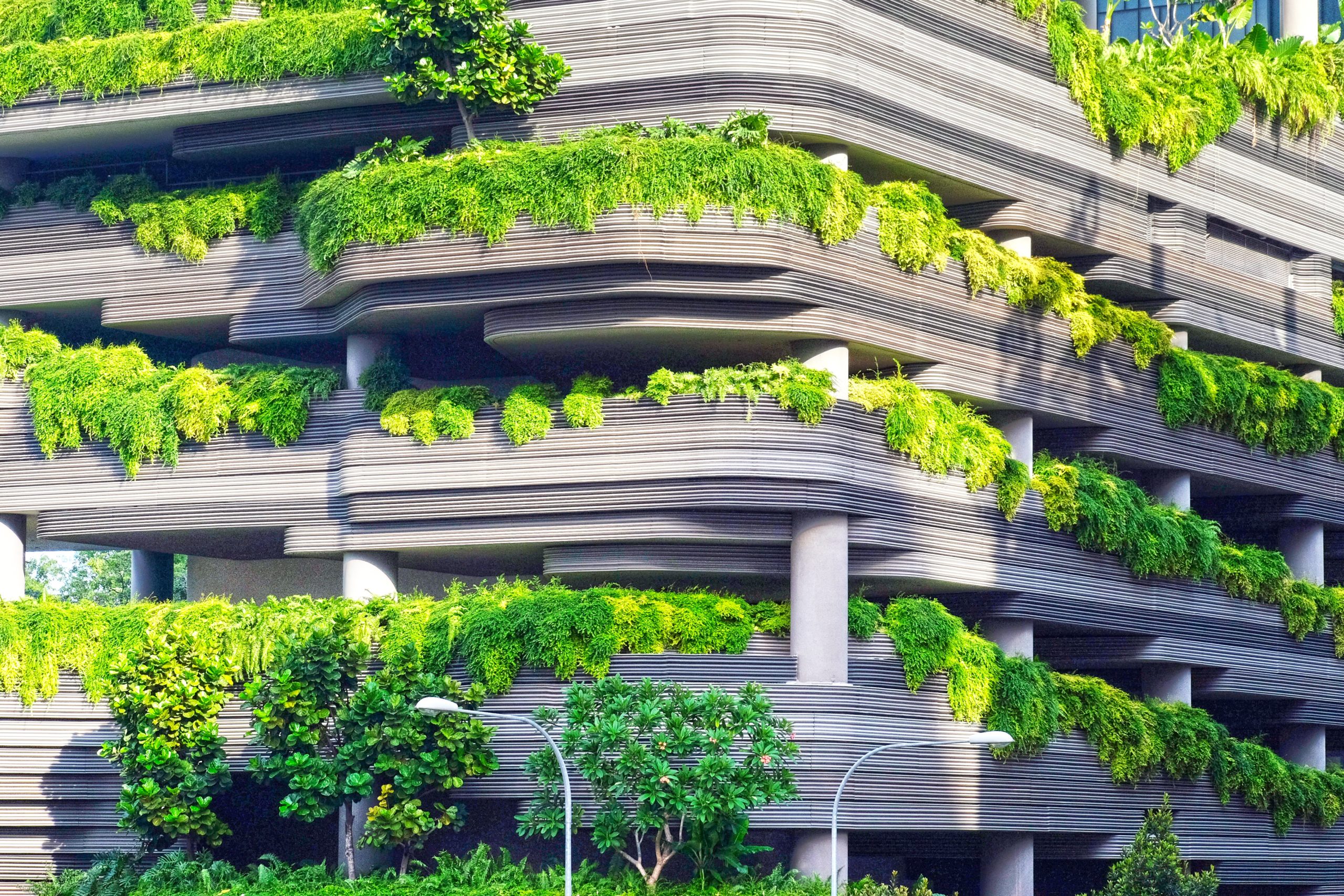The building sector is a major player in the fight against climate change and the preservation of our environment. Thus, it is essential to adopt new approaches and construction methods that reduce our ecological footprint. One such approach is the “Cradle to Cradle®” concept, which aims to transform the building industry into a more sustainable and environmentally friendly model. In this article, we will explore the fundamentals of the Cradle to Cradle® concept, its benefits in the building sector, examples of achievements and how to integrate this concept to design a C2C building.
Cradle to Cradle® (C2C) concept
Origin of the concept
The Cradle to Cradle® concept was developed by the American architect and designer William McDonough and the German chemist Michael Braungart. They introduced this approach in their book “Cradle to Cradle®: Remaking the Way We Make Things”, published in 2002. Their goal was to create a new vision of production and consumption, where waste becomes a resource and products are designed to be recycled or reused.
The 5 basic principles of C2C
The Cradle to Cradle® concept is based on five fundamental principles:
- There is no such thing as waste: It is about designing products so that their components can be recovered and reused at the end of their life cycle, creating a waste-free material loop.
- Use renewable energy: Buildings must be designed to minimize their energy consumption and favor the use of renewable energy, such as solar, wind or geothermal.
- Preserve water quality: Projects must be designed to prevent water pollution and encourage on-site water treatment and reuse.
- Promoting diversity: The C2C concept encourages biodiversity and the creation of green spaces integrated into buildings to improve the quality of life of occupants.
- Adopt an ethical and social approach: Projects must respect the rights of workers and local communities, and promote a fair and inclusive economy.
Benefits of the Cradle to Cradle® concept in the building sector
Environmental sustainability
C2C buildings are designed to minimize their impact on the environment throughout their life cycle. This translates into a reduction in greenhouse gas emissions, better management of natural resources and a reduction in waste production.
Circular economy
The C2C concept promotes the circular economy by encouraging the reuse, repurposing and recycling of building materials. Thus, buildings become reservoirs of resources (also called“material bank buildings“) that can be recovered, reused or even upcycled at the end of their life cycle.
Improved quality of life
C2C buildings integrate green spaces and promote biodiversity, which contributes to improving the quality of life of occupants and residents. In addition, the use of healthy and non-toxic materials ensures a healthy indoor environment for users.
Cradle to Cradle® certification and buildings: the concept of “C2C-inspired Building
It is important to note that a building itself cannot be certified as Cradle to Cradle®. C2C certification applies to materials, products and systems, but not directly to buildings. However, a building can be made of C2C-certified materials and be considered a “C2C-inspired building”. This means that the construction project follows Cradle to Cradle® principles and incorporates C2C-certified elements in its design, without being certified itself. However, the building can be referenced to the international “Cradle to Cradle®- inspired Building” register.
Steps and conditions to be referenced
The website www.C2C-Buildings.net lists buildings that are inspired by Cradle to Cradle® principles and incorporate C2C-certified materials. For a building to be published on this site, it must meet certain conditions and follow a specific process.
Conditions to be respected
- The building must integrate a “delight”, a “delight” that is to say a functionality, a service, a particularity that distinguishes it from the others, as in nature where each species brings “its share”,
- The project must respect Cradle to Cradle® principles, such as the use of renewable energy, water management and biodiversity preservation, Cradle to Cradle® certified products
- The building must be completed and operational.
Publication process
- Project Submission: The owner or design team submits information about the building and C2C-certified elements incorporated into the project by completing an online form at www.C2C-Buildings.net.
- Verification of information: The team verifies the information provided and ensures that the building meets the conditions stated above.
- Publication on the website: If the building meets the criteria, it is added to the list of “C2C-inspired Buildings” on the website www.C2C-Buildings.net, with a detailed description of the project and the C2C-certified elements used.
By having their building published on C2C-inspired Buildings, industry players can showcase their commitment to Cradle to Cradle® principles and inspire other projects to adopt this sustainable and innovative approach.
Designing a C2C building
Choice of materials
To respect C2C principles, it is important to select healthy and circular materials, i.e. recyclable, renewable and non-toxic. This facilitates their reuse and ensures a healthy environment for the occupants.
Energy and water management
The design of a Cradle to Cradle® inspired building must include optimized energy and water management. This can include the use of renewable energy, optimization of thermal insulation, heat recovery or the reuse of grey water and rainwater.
Biodiversity and green spaces
Integrating green spaces and encouraging biodiversity is essential to create a building that respects the C2C concept. Green roofs, shared gardens or green walls are solutions to consider.
Cradle to Cradle® Certification
Evaluation criteria
Cradle to Cradle® certification evaluates projects on several criteria, including non-toxicity of materials, reuse of resources, use of renewable energy, water management and social equity.
Certification levels
The Cradle to Cradle® version 4 certification has five levels: Basic, Bronze, Silver, Gold and Platinum. Each level reflects the performance of the certified product against the evaluation criteria.
Barriers and challenges to Cradle to Cradle® adoption
While the Cradle to Cradle® methodology has many benefits, there are also challenges to overcome in order to promote its adoption in the building sector.
Lack of awareness and training
The Cradle to Cradle® concept is still relatively unknown among building professionals. To encourage its adoption, it is essential to educate and train the actors of the sector, such as architects, engineers, project owners and contractors.
Higher initial cost
The construction of a Cradle to Cradle® inspired building can represent an initial cost identical to that of a so-called “green” building due to the choice of recyclable and renewable materials, as well as advanced energy and water technologies. However, it is important to emphasize that these investments are profitable in the long term thanks to the savings in energy, water but also the recoverable value of the products at the end of use in the operation phase in circular economy.
Availability of materials and technologies
The Cradle to Cradle® concept is gaining momentum and the demand for C2C products is accelerating. It is not always easy to find the right certified product that fits the needs of the project. Fortunately, there is a Circular Passport Library that references C2C products and materials and allows for comparison.
Examples of Cradle to Cradle®-inspired buildings
MobileWood
 Mobil Wood is a wood pellet factory located in Saint-Bris-le-Vineux. It is the first eco-recyclable factory in Europe. It uses local raw materials such as wood residues from sawmills and the surrounding forest, thus reducing its carbon footprint.
Mobil Wood is a wood pellet factory located in Saint-Bris-le-Vineux. It is the first eco-recyclable factory in Europe. It uses local raw materials such as wood residues from sawmills and the surrounding forest, thus reducing its carbon footprint.
The plant is also designed to be fully demountable and recyclable, maximizing the reuse of materials when the plant is dismantled. In addition, Mobil Wood provides local jobs in a region where the wood industry is an important part of the economy.
Senior House of La Chapelle Thouarault
 The Senior House of La Chapelle Thouarault is a residence for seniors located in Brittany, France. The building was designed by social landlord Neotoa, which was inspired by Cradle to Cradle® principles to create a healthy and sustainable environment. The residence incorporates C2C certified materials and environmentally friendly technologies, such as a rainwater harvesting system and solar panels for renewable energy production.
The Senior House of La Chapelle Thouarault is a residence for seniors located in Brittany, France. The building was designed by social landlord Neotoa, which was inspired by Cradle to Cradle® principles to create a healthy and sustainable environment. The residence incorporates C2C certified materials and environmentally friendly technologies, such as a rainwater harvesting system and solar panels for renewable energy production.
These examples illustrate how Cradle to Cradle® principles can be applied to different types of buildings and contribute to the transition to more sustainable and environmentally friendly construction.
Conclusion
The Cradle to Cradle® concept offers a new vision of sustainable construction, placing the circular economy, environmental preservation and quality of life at the heart of projects. More and more buildings are adopting this approach, showing that the transition to a more planet-friendly model is possible and necessary.
